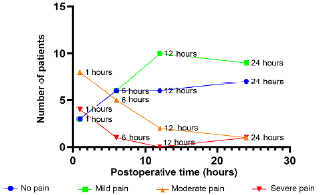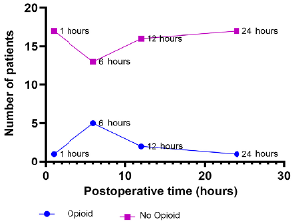Letter to the Editor
Is the erector spinae plane block useful in abdominal surgery?
a Medical Program, Anesthesiology Service, School of Health Sciences. Universidad del Quindío. Armenia, Colombia.
b ESE San Juan de Dios University Hospital, Quindio Department. Armenia, Colombia.
c Medical Program, Anesthesiology Service, School of Medicine, Alexander Von Humboldt University. Armenia, Colombia.
d Medical Program, School of Health Sciences, GEPAMOL research group. Universidad del Quindío. Armenia, Colombia.
Multimodal analgesia in the treatment of postoperative pain has gained popularity because of reduced opioid use and, consequently, less side effects 1,2. The erector spinae plane (ESP) block under ultrasound guidance has been recently proposed as part of postoperative pain management 3-12. In our experience, adding this technique in 18 patients scheduled for abdominal and gynecological surgery in a Level III center in Armenia, Quindío, has produced interesting results. Erector spinae plane block was performed as part of the regular anesthetic procedure in an interfascial plane under direct ultrasound visualization, using T7-T8 as the target; 10 cm3 of 1% lidocaine with no epinephrine plus 10 cm3 of 0.5% bupivacaine with epinephrine were injected in the deep fascial plane into the spinae erector muscle group in order to obtain craniocaudal spread. All patients were monitored in the first hour and then at 6 h, 12 h and 24 h.
Postoperative pain, need for opioids and side effects were assessed at every time point. Of the total number of procedures, 61% (11/18) were abdominal hysterectomies, while the remaining consisted of cholecystectomy, ovarian resection and eventration repair. Between 12 and 24 hours, absence of pain was observed in 7 patients which 9 reported mild, non-debilitating pain (Figure 1). On the other hand, only 5 patients required rescue analgesia at some point during the follow-up period (Figure 2). Rescue regimens were based on fentanyl, tramadol or morphine; median 24-consumption according to an equivalent oral morphine dose was 15 mg (range: 3-23 mg). Finally, out of 18 patients, only 3 had nausea and vomiting and 4 experienced only nausea. No technique-related complications were observed during the postoperative follow-up period. Ultrasound-guided ESP block provides control of acute postoperative pain as part of multimodal analgesia, especially between 12 and 24 hours after abdominal surgery. Further more robust research is warranted in this setting, including experimental studies and controlled clinical trials in particular, in order to confirm the effectiveness and safety of this technique.
REFERENCES
1. Karaca Ó. Efficacy of ultrasound-guided bilateral erector spinae plane block for pediatric laparoscopic cholecystectomy: Case Series. Agri - J Turkish Soc Algol. 2019;31(4):209-13. doi: http://www.doi.org/10.14744/agri.2019.88896
[ Links ]
2. Català Puigbò E, Moral García MV. Dolor agudo postoperatorio. La necesidad de su correcto tratamiento. Cir Esp. 2009;86(2):61-2. doi: http://www.doi.org/10.1016/j.ciresp.2009.03.024
[ Links ]
3. Benavides L, Heredia R, Pacheco LJ, Salazar LA. Erector spinae plane block as a rescue analgesia technique in a patient with Heart-Mate 3 ventricular assist type device: Case report. Colombian Journal of Anesthesiology. 2020;48(1):40-4. doi: http://www.doi.org/10.1097/CJ9.0000000000000117
[ Links ]
4. Urits I, Charipova K, Gress K, et al. Expanding role of the erector spinae plane block for postoperative and chronic pain management. Curr Pain Headache Rep. 2019;23(10):1-6. doi: http://www.doi.org/10.1007/s11916-019-0812-y
[ Links ]
5. Altiparmak B, Korkmaz Toker M, Uysal AÍ, Turan M, Cumuç Demirbilek S. Comparison of the effects of modified pectoral nerve block and erector spinae plane block on postoperative opioid consumption and pain scores of patients after radical mastectomy surgery: A prospective, randomized, controlled trial. J Clin Anesth. 2019;54:61-5. doi: http://www.doi.org/10.1016/j.jclinane.2018.10.040
[ Links ]
6. Chin KJ, Adhikary S, Sarwani N, Forero M. The analgesic efficacy of pre-operative bilateral erector spinae plane (ESP) blocks in patients having ventral hernia repair. Anaesthesia. 2017;72(4):452-60. doi: http://www.doi.org/10.1111/anae.13814
[ Links ]
7. Singh S, Chaudhary NK. Bilateral ultasound guided erector spinae plane block for postoperative pain management in lumbar spine surgery: A case series. J Neurosurg Anesthesiol. 2019;31(3):354. doi: http://www.doi.org/10.1097/ANA.0000000000000518
[ Links ]
8. Chin KJ, Malhas L, Perlas A. The erector spinae plane block provides visceral abdominal analgesia in bariatric surgery a report of 3 cases. Reg Anesth Pain Med. 2017;42(3):372-6. doi: http://www.doi.org/10.1097/AAIP0000000000000581
[ Links ]
9. Hamilton DL. Pneumothorax following erector spinae plane block. J Clin Anesth . 2019;52:17. doi: http://www.doi.org/10.1016/j.jclinane.2018.08.026
[ Links ]
10. Altiparmak B, Korkmaz Toker M, Uysal AI, Kuççu Y, Cümüç Demirbilek S. Ultra-sound-guided erector spinae plane block versus oblique subcostal transversus abdominis plane block for postoperative analgesia of adult patients undergoing laparoscopic cholecystectomy: Randomized, controlled trial. J Clin Anesth . 2019;57:31-6. doi: http://www.doi.org/10.1016/j.jclinane.2019.03.012
[ Links ]
11. Tulgar S, Kapakli MS, Senturk O, Selvi O, Serifsoy TE, Ozer Z. Evaluation of ultrasound-guided erector spinae plane block for postoperative analgesia in laparoscopic cholecystectomy: A prospective, randomized, controlled clinical trial. J Clin Anesth . 2018;49:101-6. doi: http://www.doi.org/10.1016/j.jclinane.2018.06.019
[ Links ]
12. Selvi O, Tulgar S. Ultrasound guided erector spinae plane block as a cause of unintended motor block. Rev Española Anestesiol y Reanim (English Ed.). 2018;65(10):589-92. doi: http://www.doi.org/10.1016/j.redare.2018.05.003
[ Links ]












 text in
text in 




